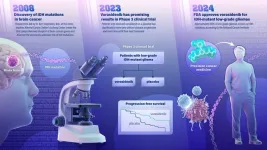(Press-News.org) Recent advancements highlight the intricate interplay between the heart and brain, underscoring their profound influence on each other, especially concerning central nervous system (CNS) neurological disorders. In light of this, a new special issue aims to explore therapeutic targets that impact both cardiac and cerebral functions. By focusing on these targets, the issue seeks to provide an in-depth understanding of the complex relationship between these vital organs.
For more information and to contribute to this research topic, please visit: bit.ly/4dvVNx1
Comprehensive analyses will uncover the implications of this relationship on the progression of various neurological disorders. The goal is to not only deepen our physiological understanding of the heart-brain connection but also to pave the way for innovative therapeutic interventions. Such advancements could revolutionize the treatment landscape for neurological disorders, offering new hope for patients.
This special issue aspires to inspire and contribute to the ongoing dialogue in medical science, fostering breakthroughs that could transform how we approach and treat these conditions.
END
Heart and brain axis targets in CNS neurological disorders
Published by Dr Melis Uzan in the journal CNS & Neurological Disorders - Drug Targets
2024-08-07
ELSE PRESS RELEASES FROM THIS DATE:
Digital Science appoints new Chief People Officer
2024-08-07
Digital Science, a technology company serving stakeholders across the research ecosystem, is pleased to announce that highly experienced human resources leader and author Claire Fox has been appointed to the role of Chief People Officer.
Claire joins the Digital Science Executive Team at a time of growth for the company, with its continued mission to drive progress for all through research and innovation.
Based in London, UK, Claire has more than 20 years’ HR experience, initially in national, European and global HR leadership roles in the fast-moving consumer goods (FMCG) sector at Unilever. She then moved into international development, with senior leadership roles including ...
West Health and UC San Diego Health partnership helps California lead nation with most accredited geriatric emergency departments
2024-08-07
SAN DIEGO – AUGUST 7, 2024 – West Health and UC San Diego Health announced today that nearly three million older adults in California now have access to specialized care for medical emergencies, making the state the nation’s leader in accredited geriatric emergency departments (GEDs). Nearly half of the state’s seniors now have access to a GED compared to about 30% of seniors nationwide.
UC San Diego Health and West Health collaborated and collectively engaged more than 650 ...
Social rank may determine if animals live fast, die young
2024-08-07
Anyone who has picnicked on the beach has experienced the unpleasant crunch of a sandwich with a surprise helping of sand. But for primates, the tolerance for sand may depend on whether their energy is better spent reproducing and fighting rivals or on protecting their teeth from a mouthful of grit, according to a new Dartmouth study.
Social rank may determine whether animals prioritize immediate energy consumption over long-term health, or vice versa, the researchers report in the journal eLife. They observed the eating habits of long-tailed ...
Cutting-edge 3D-printed microneedle technology revolutionizes remote healthcare
2024-08-07
Los Angeles, California – August 6, 2024 - In a significant leap forward for healthcare equity and accessibility, researchers at the University of Victoria and the Terasaki Institute for Biomedical Innovation (TIBI) have developed a revolutionary system that combines remote health monitoring and drug delivery using 3D-printed hollow microneedles. This innovative approach, detailed in a recent study published in Advanced Healthcare Materials, promises to transform healthcare delivery, particularly for those in underserved or remote regions.
The ...
Blood test can help predict chronic lung disease in preterm babies
2024-08-07
A blood test can help predict which preterm babies will go onto develop chronic lung disease, allowing for earlier diagnosis and more targeted treatments, according to a new study.
The research, led by Murdoch Children’s Research Institute (MCRI) and published in the American Journal of Respiratory Cell and Molecular Biology found that changes in certain blood proteins, alongside gestational age, birth weight and sex, strongly predicated bronchopulmonary dysplasia (BPD) within 72 hours of life.
BPD usually occurs when a baby’s lungs are damaged by respiratory support and the long-term ...
Demystifying APE1: New findings on direct activation of ATM signaling by DNA single-strand breaks
2024-08-07
New research from a team of genome scientists and DNA damage response experts breaks new ground in understanding the function of a protein currently limited in clinical trials for cancer treatments.
Led by Haichao Zhao, PhD, in the Yan Lab at UNC Charlotte, the new research shows how ATM-mediated signaling is induced by DNA single-strand breaks (SSBs) for DNA damage repair – illuminating the distinct mechanisms of SSB-induced ATM kinase and shedding an important light on APE1 function.
In the new study, published today in Nature Communications, ...
Study suggests an MRI may help doctors predict more aggressive prostate cancer in patients
2024-08-07
SOUTHFIELD, MI, Aug. 7, 2024 - New Corewell Health™ research suggests an MRI scan can help predict whether patients with intermediate-risk prostate cancer (cancer confined to the entire prostate) may have more aggressive cancer in five years. Knowing this could potentially help doctors determine if treatment is needed up front vs. using a method called active surveillance where the disease is closely monitored over time. The study, recently published in the Journal of Urology, is the first to evaluate this risk group.
Currently, there has been a growing trend to manage low-risk prostate cancer patients with active ...
FDA approves drug targeting Johns Hopkins-discovered brain cancer gene mutation
2024-08-07
FOR IMMEDIATE RELEASE
A new drug for treatment of a type of brain cancer, called IDH-mutant low-grade glioma, was approved Aug. 6 by the U.S. Food and Drug Administration (FDA). The promising new drug stems from a 2008 genetic discovery made at the Johns Hopkins Kimmel Cancer Center.
The drug, called vorasidenib, is a targeted cancer therapy that works by inhibiting the activity of a mutated gene called IDH, slowing the growth of the cancer. The gene was identified by Bert Vogelstein, M.D., and team at the Johns Hopkins Kimmel Cancer Center’s ...
LOINC® semiannual release: Global partners collaborate to enhance semantic interoperability with health terminology updates
2024-08-07
INDIANAPOLIS -- Regenstrief Institute’s latest LOINC® content update underscores significant strides in health terminology, accomplished through extensive collaboration with the international health community. The semiannual release aims to bolster the electronic exchange of clinical and laboratory data, fostering the use and implementation of LOINC standards across healthcare systems globally.
The Regenstrief Institute Health Data Standards (HDS) unit, which administers LOINC, and partners collaborated to create more than 3,000 updates, including ...
Researchers show pesticide contamination is more than apple skin deep
2024-08-07
Pesticides and herbicides are critical to ensuring food security worldwide, but these substances can present a safety risk to people who unwittingly ingest them. Protecting human health, therefore, demands sensitive analytical methods to identify even trace levels of potentially harmful substances. Now, researchers reporting in ACS’ Nano Letters have developed a high-tech imaging method to detect pesticide contamination at low levels, and its application on fruits reveals that current food safety practices ...
LAST 30 PRESS RELEASES:
Support for parents with infants at pediatric check-ups leads to better reading and math skills in elementary school
Kids’ behavioral health is a growing share of family health costs
Day & night: Cancer disrupts the brain’s natural rhythm
COVID-19 vaccination significantly reduces risk to pregnant women and baby
The role of vaccination in maternal and perinatal outcomes associated with COVID-19 in pregnancy
Mayo Clinic smartwatch system helps parents shorten and defuse children's severe tantrums early
Behavioral health spending spikes to 40% of all children’s health expenditures, nearly doubling in a decade
Digital cognitive behavioral treatment for generalized anxiety disorder
Expenditures for pediatric behavioral health care over time and estimated family financial burden
Air conditioning in nursing homes and mortality during extreme heat
The Alps to lose a record number of glaciers in the next decade
What makes a good proton conductor?
New science reporting guide published for journalists in Bulgaria
New international study reveals major survival gaps among children with cancer
New science reporting guide published for journalists in Turkey
Scientists develop a smarter mRNA therapy that knows which cells to target
Neuroanatomy-informed brain–machine hybrid intelligence for robust acoustic target detection
Eight SwRI hydrogen projects funded by ENERGYWERX
The Lundquist Institute and its start-up company Vitalex Biosciences Announces Strategic Advancement of Second-Generation fungal Vaccine VXV-01 through Phase 1 Trials under $40 Million Competitive Con
Fine particles in pollution are associated with early signs of autoimmune disease
Review article | Towards a Global Ground-Based Earth Observatory (GGBEO): Leveraging existing systems and networks
Penn and UMich create world’s smallest programmable, autonomous robots
Cleveland researchers launch first major study to address ‘hidden performance killer’ in athletes
To connect across politics, try saying what you oppose
Modulating key interaction prevents virus from entering cells
Project explores barriers to NHS career progression facing international medical graduates
Jeonbuk National University researchers explore the impact of different seasonings on the flavor perception of Doenjang soup
Two Keck Medicine of USC Hospitals named Leapfrog Top Teaching Hospitals
World-first discovery uncovers how glioblastoma tumours dodge chemotherapy, potentially opening the door to new treatments
A fatal mix-up: How certain gut bacteria drive multiple sclerosis
[Press-News.org] Heart and brain axis targets in CNS neurological disordersPublished by Dr Melis Uzan in the journal CNS & Neurological Disorders - Drug Targets





